Banking Memecoins: Inside the International Meme Fund

In crypto investing, short-tail assets are blockbuster assets that are highly liquid and routinely traded, like BTC, ETH, SOL, etc. In contrast, long-tail assets are smaller, less liquid, and see more infrequent trading.
If you're a degen onchain trader, you're no stranger to the long-tail end of the spectrum where memecoins live and die.
That said, the memecoin market is currently larger than $69 billion per CoinGecko! And the meme verticals on various chains, like Base, seem poised to grow much more in the years ahead.
Cue the International Meme Fund.
The problem at hand? Most larger DeFi protocols tend to focus on short-tail onchain assets, as they're proven, liquid, and always in demand.
This dynamic leaves a gap in the market for holders of higher-quality memecoins, i.e. holders who don't currently have many choices around borrowing and lending opportunities in the DeFi ecosystem.
As such, the IMF, which is seeing growing traction on Base, aims to "bank the unbankable," through a bespoke lending protocol that offers credit markets to overlooked memecoins.
IMF crossed $100M in TVL 👏 pic.twitter.com/iRGPsikVsv
— Gami 🌐 IMF (@gamiwtf) July 9, 2025
I found this project via Gami, its main steward, who is a luminary of the Nouns DAO and Gnars DAO communities. I always try to keep an eye on what Nouners are working on, so IMF has triggered my attention.
The big idea here? Use your $MOG , $PEPE, $IMF, and (more memes to come) as collateral to borrow against. The keystone stablecoin here is Sky Protocol's $USDS, which you can draw against using your memecoins.
Under the hood, the IMF protocol is built atop Morpho's Multi-Market Factory. In other words, each token sits inside an isolated Morpho Market, so e.g. if $PEPE nukes 50% overnight it can’t drag $MOG lenders down with it, etc.
IMF borrowers can tap up to 50% loan‑to‑value (LTV) in $USDS, Sky's aforementioned overcollateralized stablecoin, and liquidations only trigger once positions breach 77% Liquidateable LTV (LLTV). Not a bad deal for volatile, higher-risk assets!
Beyond vanilla lending you get a few one‑click goodies here:
- Accelerate — This feature loops your collateral, taking a 150 % long at a safer 33 % starting LTV, i.e. tempered leverage.
- Amplify — This feature routes single‑sided token deposits into an optimized Uniswap v3 LP to pair with USDS for streamlined yields.
- Allocate — This feature lets $IMF holders vote on where USDS liquidity flows next for incentivizing new markets.
For memecoin projects, this kind of credit system fills a structural gap. And borrowing against conviction aligns incentives: you repay your loans better if your collateral token rises in price. Meanwhile, lenders can farm real yields here instead of inflationary emissions, and the underlying tokens themselves earn deeper liquidity.
All in all, what's most interesting to me with IMF is what it potentially bodes for the future.
If isolated Morpho vaults and overcollateralized USDS can keep a $PEPE lending market solvent, this template can expand to Zora Coins, niche NFTs, even exotic real-world assets (RWAs). IMF could become a proving ground for next-gen permissionless credit engines.
My bottom line? IMF won’t necessarily make memecoins less volatile by itself, but it does give their believers a new toolbox. If the meme economy is going to mature, treating conviction as bankable collateral is a logical next step worth watching!